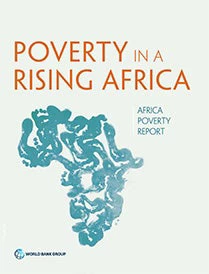
Researchers interested in understanding poverty dynamics in Africa now have access to an emerging collection of nationally representative panel surveys (see, for example, Living Standards Measurement Study–Integrated Surveys on Agriculture). This is a vast improvement over the situation just a decade ago. However, data coverage remains low – only seven countries– and the time period spanned is limited to 2-4 years. So, what to do to get a picture of poverty dynamics for most of SSA, and over a longer time period?
In a background paper for the recent Poverty in a Rising Africa report, we construct synthetic panels instead from available cross sectional household surveys, which have been proven to perform well when validated against data from actual panels (for details see our earlier blog). These synthetic panels are much more widely available and span longer time periods; they also enable a more systematic application of the same methodology across countries, which improves comparability. A similar approach has been applied recently for countries in the Latin America and Middle East and North Africa regions.
Here, synthetic panels were constructed for 21 countries with at least two comparable surveys accounting for 66% of the SSA population and spanning on average six years. Each country’s poverty rate - using the $1.90 per day in 2011 purchasing power parity (PPP) dollars – was subsequently decomposed into four components: 1) chronically poor (households that were poor in both periods), 2) downwardly mobile (households that fell into poverty in the second period), 3) upwardly mobile (fraction of households which were poor in the first period but not in the second) and 4) the non-poor (households that were never poor). Two important insights emerge (figure 1):
- First, on average about 35% of Africans are chronically poor (i.e., poor in both periods). Another 25% are transiently poor (i.e., poor in either one of the two periods) with 11% experiencing downward mobility, and 14% upward mobility in period two. Put differently, among those who were poor in either one of the two periods considered (i.e. 60% of the population or around 250 million people in our estimation sample), 58% (or around 145 million people) were chronically poor (= 35/60).
- Second, countries that are similar in terms of poverty rates may be dissimilar in terms of poverty dynamics. For instance, Burkina Faso and Sierra Leone both show poverty rates of about 55%, but the share of chronically poor people is larger in Burkina Faso. Also, in some of the countries that appear to have had success in reducing poverty, a large share of the poor are chronically poor. Botswana, for example, has poverty rates that are among the lowest in the region, but almost all of its poor are chronically so (for more details see the Poverty in a Rising Africa report).
Figure 1: Headcount Poverty Decomposed by Chronic Poverty, Downward Mobility, and Upward Mobility

This blog is part of a series reflecting on the findings of the 2016 World Bank Report “Poverty in a Rising Africa." Next in the series: measuring inflation with Engel curves in Africa on March 21, 2016. Previous blogs in the series include:
- Africa is rising! But are people better off?
- Who will fund poverty surveys in Volkswagen countries?
- The European refugee crisis: What we can learn from refugees in Sub-Saharan Africa
- Poverty is falling faster for female-headed households in Africa
- The shock of widowhood: Marital status and poverty within Africa
- Domestic Violence and Poverty in Africa: When a Husband’s Beating Stick is Like Butter
- Data gaps: The poor typical household survey’s miss
- Inequality of opportunity in Sub-Saharan Africa
- Is inequality in Africa rising?
- Education for all in a “rising Africa”
- When growth alone is not enough
- Yep, about reading and writing again
- A glimpse behind the curtain: CPIs in Africa



Join the Conversation